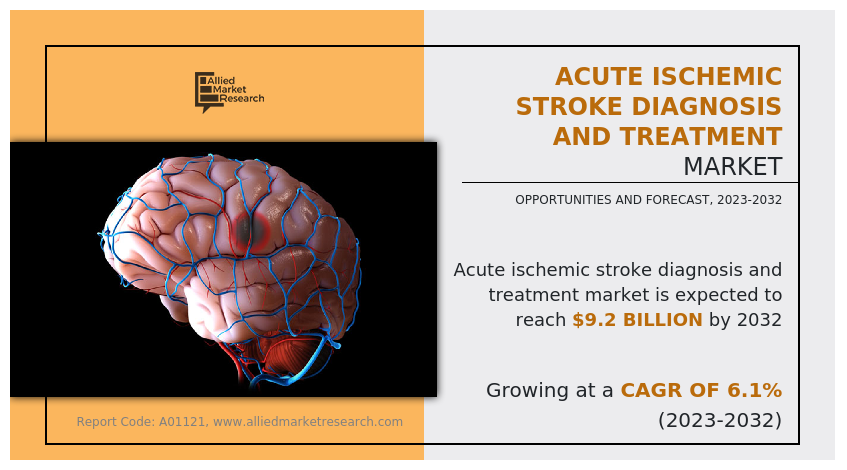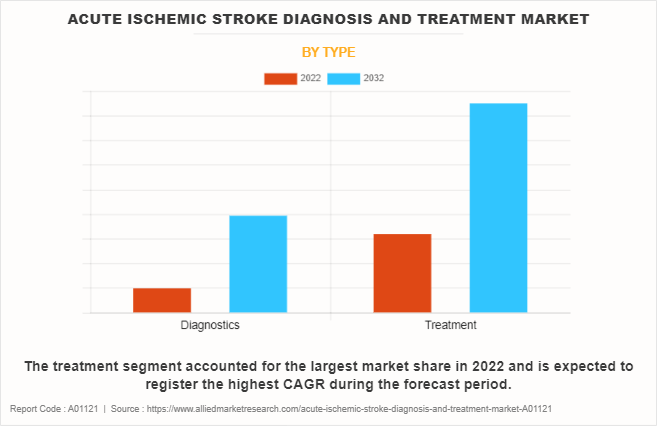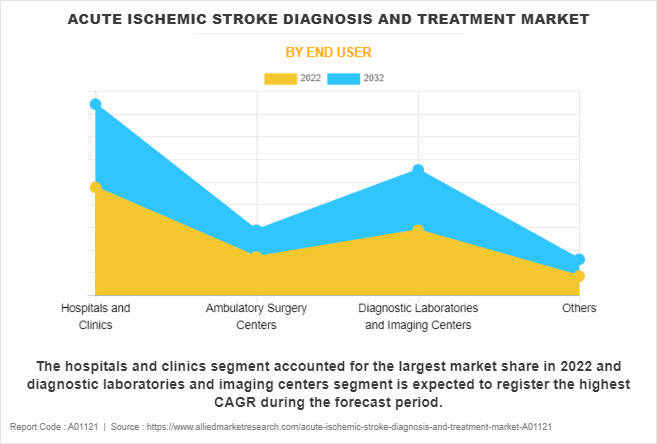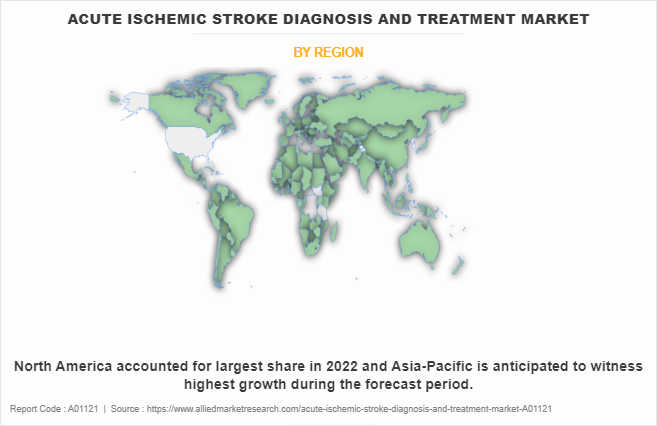Acute Ischemic Stroke Diagnosis And Treatment Market Research, 2032
The global acute ischemic stroke diagnosis and treatment market size was valued at $5.1 billion in 2022, and is projected to reach $9.2 billion by 2032, growing at a CAGR of 6.1% from 2023 to 2032. The growth of the acute ischemic stroke diagnosis and treatment market is driven by a rise in incidences of acute ischemic stroke around the globe and technological advancements in ischemic stroke diagnostics. For instance, according to the World Stroke Organization (WSO) 2022, each year over 58% of ischemic strokes occur in people under 70 years of age. The rise in incidence of ischemic stroke led to an increase in demand for acute ischemic stroke diagnostics and therapeutics, which, in turn, drives the market growth.

Key Takeaways:
- By type, the treatment segment dominated the global market in 2022.
- By end user, the hospitals and clinics segment dominated the market in terms of revenue in 2022.
- By region, North America dominated the market in terms of revenue in 2022. However, Asia-Pacific is anticipated to grow at the highest CAGR during the forecast period.
Acute ischemic stroke is a medical condition characterized by a sudden disruption of blood flow to a part of the brain, leading to a lack of oxygen and nutrients. This ischemic event results from the blockage or obstruction of a blood vessel supplying the brain, commonly due to a blood clot or the formation of a thrombus. The sudden reduction or cessation of blood flow deprives brain cells of essential nutrients, leading to damage or death of the affected brain tissue. There are various diagnostic tests such as CT scans, MRI, and blood tests, to determine the type and severity of stroke. Ischemic stroke treatment incudes the administration of anticoagulants, tissue plasminogen activators, antihypertensive medications, and antiplatelet drugs.
Market Dynamics
The increase in the incidence of acute ischemic stroke is a significant driver for the acute ischemic stroke diagnosis and treatment industry. Factors such as aging population, lifestyle changes, and the increasing prevalence of risk factors like hypertension contribute to a higher occurrence of strokes which led to rise in demand for diagnosis and treatment.
In addition, rise in technological advancements in diagnostic imaging, such as computed tomography (CT) and magnetic resonance imaging (MRI), enable accurate and timely diagnosis of acute ischemic strokes drive the acute ischemic stroke diagnosis market growth. High-resolution imaging allows healthcare professionals to visualize brain structures and identify the location and extent of ischemic damage.The aging population is more prone to stroke, and as the global population ages, the demand for stroke treatment is likely to increase. Age is a significant risk factor for stroke, and the elderly population often requires more extensive medical interventions. Thus, the rise in geriatric population further drive the acute ischemic stroke treatment market size.
Furthermore, rise in government initiatives and support for stroke prevention and management which contribute to the growth of acute ischemic stroke diagnosis market. Funding, research programs, and the establishment of stroke centers enhance the infrastructure and capabilities for effective diagnosis and treatment proples the acute ischemic stroke treatment market size.
Moreover, rise in public awareness of stroke symptoms, risk factors, and importance of seeking immediate medical attention has led to a shift in patient behavior which supports market growth. Increased awareness contributes to early detection, diagnosis, and prompt initiation of treatment, enhancing overall outcomes which fuels the acute ischemic stroke diagnosis and treatment market growth.
However, high cost of diagnostic and treatment for ischemic stroke is projected to deter individuals from seeking early diagnosis, particularly in regions with limited access to affordable healthcare. This negatively impacts the market growth. Patients may postpone or avoid diagnostic tests due to concerns about the financial burden and restrain market growth. On the other hand, technological advancement in ischemic stroke diagnosis and increase in new product approvals are expected to create lucrative acute ischemic stroke diagnosis and treatment market opportunity during the forecast period.
The ongoing global economic recession influences several industries, including medical technology and pharmaceuticals, which has an impact on the development and demand for acute ischemic stroke diagnosis and treatments. During a recession, the medical technology industry is moderately impacted due to increase in cost for supplies, healthcare providers, and instruments. Further, reduction in research funding is slowing down the development of new treatment and technologies.
Despite these challenges, the acute ischemic stroke diagnosis and treatment market continues to experience moderate revenue growth owing to technological advancements in imaging. Thus, the acute ischemic stroke diagnosis and treatment market is moderately impacted by recession.
Segments Overview
The acute ischemic stroke diagnosis and treatment market size is segmented on the basis of type, end user, and region. On the basis of type, the market is categorized into diagnostics and treatment. The diagnostics segment is further categorized into computed tomography, magnetic resonance imaging, carotid ultrasound, cerebral angiography, electrocardiography, echocardiography, and others. The treatment segment is bifurcated into thrombolytic therapy and mechanical thrombectomy. The thrombolytic therapy segment is further classified into tissue plasminogen activator, antiplatelet, and others. The mechanical thrombectomy segment is categorized into stent retriever, aspiration catheter, and combination (stent retriever and aspiration catheter). By end user, the market is classified into the hospitals and clinics, diagnostic laboratories and imaging centers, and others.
Region-wise, the market is analyzed across North America (the U.S., Canada, and Mexico), Europe (Germany, France, the UK, Italy, Spain, and rest of Europe), Asia-Pacific (China, Japan, Australia, India, South Korea, and rest of Asia-Pacific), and LAMEA (Brazil, South Africa, Saudi Arabia, and rest of LAMEA).
By Type
The treatment segment dominated the acute ischemic stroke diagnosis and treatment market share in 2022. This is attributed to the increase in adoption of advanced interventions such as thrombolytic therapy and mechanical thrombectomy. In addition, technological advancements, coupled with streamlined stroke care protocols and increased public awareness, further support the segment growth.

By End User
The hospitals and clinics segment dominated the acute ischemic stroke diagnosis and treatment market share in terms of revenue in 2022. The growth of the segment is attributed to the easy accessibility, well established infrastructure, and ability to deliver timely interventions, such as thrombolytic therapy and mechanical thrombectomy.
However, diagnostic laboratories and imaging centers and is anticipated to be the fastest growing segment during the forecast period owing to increase in demand for early and precise detection of ischemic strokes, coupled with rise in prevalence of ischemic stroke and their risk factors.

By Region
The acute ischemic stroke diagnosis and treatment industry is analyzed across North America, Europe, Asia-Pacific, and LAMEA. North America dominated the market in terms of revenue in 2022. The growth in this region is attributed to the advanced healthcare infrastructure, rise in incidence of acute ischemic stroke, and adoption of technologically advanced diagnostics. In addition, the presence of several major players, such as AstraZeneca, F. Hoffmann-La Roche Ltd, Koninklijke Philips N.V., Simens, Medtronic plc, and Abbott Laboratories contributes to the market growth in the region.

Asia-Pacific is expected to grow at the highest rate during the forecast period. This is attributed to surge in awareness about ischemic stroke in the general population. In addition, rise in research and clinical trials, surge in awareness, and increase in demand for advanced treatment options for acute ischemic stroke are the factors that drive the market growth in this region.
Asia-Pacific offers profitable opportunities for key players operating in the acute ischemic stroke diagnosis and treatment market, thereby registering the fastest growth rate during the acute ischemic stroke diagnosis and treatment market forecast period, owing to the developments in infrastructure of industries and rise in adoption of the advanced medical technologies. In addition, rise in awareness about the benefits of timely medical intervention and the importance of early diagnosis and treatment have driven the demand for acute ischemic stroke diagnosis and treatment and propel the market growth.
Competition Analysis
Competitive analysis and profiles of the major players in the acute ischemic stroke diagnosis and treatment market, such as AstraZeneca plc, F. Hoffmann-La Roche Ltd., Boehringer Ingelheim International GmbH, GE Healthcare, Koninklijke Philips N.V., Siemens, Abbott Laboratories Medtronic plc, Johnson & Johnson, and Stryker Corporation are provided in the report. Major players have adopted product approval, partnership, and agreement as a key developmental strategy to improve the product portfolio and gain a strong foothold in the acute ischemic stroke diagnosis and treatment market.
Recent Product Approvals in the Acute Ischemic Stroke Diagnosis and Treatment Market
- In July 2022, Siemens Healthineers announced the Food and Drug Administration (FDA) clearance of the MAGNETOM Free.Star, a cost-effective whole-body magnetic resonance (MR) scanner designed to help improve patient access to MRI.
- In July 2021, Siemens Healthineers announced the Food and Drug Administration (FDA) clearance of the MAGNETOM Free.Max, a new High-V magnetic resonance (MR) scanner that combines a 0.55 Tesla (0.55T) field strength with deep learning technologies and advanced image processing.
- In August 2021, Abbott announced that the U.S. Food and Drug Administration (FDA) approved the company's Amplatzer Amulet Left Atrial Appendage Occluder to treat people with atrial fibrillation (AFib) who are at risk of ischemic stroke.
- In November 2020, AstraZeneca received the approval for Brilinta (ticagrelor in the US to reduce the risk of stroke, a leading cause of disability and death worldwide, in patients with acute ischemic stroke (National Institutes of Health Stroke Scale score ≤5) or high-risk transient ischemic attack).
Recent Agreement in the Acute Ischemic Stroke Diagnosis and Treatment Market
- In May 2023, Siemens Healthineers and CommonSpirit Health have agreed to acquire Block Imaging. This new acquisition will provide more sustainable options and support increasing demand from U.S. hospitals, health systems, and other care sites for multi-vendor imaging parts and services.
Recent Partnership in the Acute Ischemic Stroke Diagnosis and Treatment Market
- In October 2023, Koninklijke Philips N.V., a global leader in health technology, and the World Stroke Organization (WSO), the world’s only global non-governmental organization focused on stroke, announced the signing of a two-year partnership aimed at improving access to high-quality stroke care.
- In July 2021, Koninklijke Philips N.V., a global leader in health technology, announced a strategic partnership agreement with NICO.LAB, a MedTech stroke care company. Together with the recently expanded stroke capabilities of Philips Image Guided Therapy System – Azurion – this new partnership significantly advances Philips’ commitment to improving outcomes for people who suffer a stroke.
Recent Product Upgrade in the Acute Ischemic Stroke Diagnosis and Treatment Market
- In September 2020, Koninklijke Philips N.V., a global leader in health technology, announced its next-generation Philips Azurion image-guided therapy platform, marking an important step forward in optimizing clinical and operational lab performance and expanding the role of image-guided interventions in the treatment of patients. The Azurion image-guided therapy platform now integrates control of imaging, physiology, hemodynamic and informatics applications
Key Benefits For Stakeholders
- This report provides a quantitative analysis of the market segments, current trends, estimations, and dynamics of the acute ischemic stroke diagnosis and treatment market analysis from 2022 to 2032 to identify the prevailing acute ischemic stroke diagnosis and treatment market opportunities.
- The market research is offered along with information related to key drivers, restraints, and opportunities.
- Porter's five forces analysis highlights the potency of buyers and suppliers to enable stakeholders make profit-oriented business decisions and strengthen their supplier-buyer network.
- In-depth analysis of the acute ischemic stroke diagnosis and treatment market segmentation assists to determine the prevailing market opportunities.
- Major countries in each region are mapped according to their revenue contribution to the global market.
- Market player positioning facilitates benchmarking and provides a clear understanding of the present position of the market players.
- The report includes the analysis of the regional as well as global acute ischemic stroke diagnosis and treatment market trends, key players, market segments, application areas, and market growth strategies.
Acute Ischemic Stroke Diagnosis and Treatment Market Report Highlights
| Aspects | Details |
| Market Size By 2032 | USD 9.2 billion |
| Growth Rate | CAGR of 6.1% |
| Forecast period | 2022 - 2032 |
| Report Pages | 228 |
| By Type |
|
| By End User |
|
| By Region |
|
| Key Market Players | Boehringer Ingelheim International GmbH, Stryker Corporation., Medtronic plc, AstraZeneca plc, F. Hoffmann-La Roche Ltd., GE Healthcare, Siemens, Koninklijke Philips N.V., Johnson & Johnson, Abbott Laboratories |
Analyst Review
This section provides various opinions of acute ischemic stroke diagnosis and treatment market. An increase in demand for acute ischemic stroke diagnosis and treatment and rise in awareness about the importance of early diagnosis & treatment are expected to offer profitable opportunities for the expansion of the market. However, high cost of treatment hinders the market growth.
In addition, increase in incidences of acute ischemic stroke and rise in awareness regarding the potential benefits of advanced acute ischemic stroke diagnosis and treatment have led to an increase in demand for diagnosis and treatment options across the globe, which is expected to fuel the market growth during the forecast period. In addition, surge in collaboration between market key players to expand their businesses in different regions further supports market growth.
Furthermore, North America is expected to witness the largest growth, in terms of revenue, owing to a rise in prevalence of stroke, high adoption of the diagnostic products, and easy availability of acute ischemic stroke diagnosis and treatment products. However, Asia-Pacific is expected to register the highest CAGR during the forecast period, owing to rise in technological advancement, development of healthcare settings, and surge in prevalence of acute ischemic stroke.
The total market value of acute ischemic stroke diagnosis and treatment market is $5.1 billion in 2022.
The market value of acute ischemic stroke diagnosis and treatment market in 2032 is $9.2 billion.
The base year is 2022 in acute ischemic stroke diagnosis and treatment market.
The forecast period for acute ischemic stroke diagnosis and treatment market is 2023 to 2032.
Siemens, Stryker Corporation, Johnson & Johnson, F. Hoffmann-La Roche Ltd., Medtronic plc, held a high market position in 2022.
The growth of the acute ischemic stroke diagnosis and treatment market is primarily driven by increasing awareness, early intervention initiatives, and advancements in diagnostic technologies, fostering timely and effective stroke management.
North America held the largest market share, attributing to its advanced healthcare infrastructure, early adoption of technologies, and proactive healthcare policies.
Acute ischemic stroke refers to a sudden blockage of blood flow to a part of the brain, leading to a lack of oxygen and nutrients. This medical emergency can result in severe neurological deficits and complications.
Loading Table Of Content...
Loading Research Methodology...



